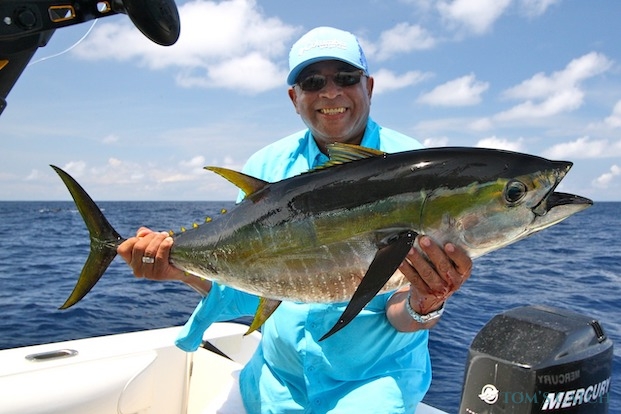Yellowfin tuna are renowned for their rapid growth, reaching up to 400 pounds (180kg) within a 7-year lifespan, and measuring between 59 to 88 inches in length. Their torpedo shape, pointed nose, sickle-shaped tail, dark blue backs, yellow sides, and silver undersides make them easily identifiable.
Techniques for Catching Yellowfin Tuna
Yellowfin tuna are primarily caught by trolling with artificial lures such as Rapala, Halco, trolling skirts, Skirted Ballyhoo Lures, and cedar plugs. Essential tackle includes topwater poppers, surface jerkbait, and crankbait jigs.
Top Yellowfin Tuna Fishing Destinations
Yellowfin tuna inhabit tropical and subtropical oceans worldwide. Notable fishing destinations include:
Baja California, Southern California (Mexico), Panama, Costa Rica, Hawaii, the Caribbean, and Cabo San Lucas in Mexico.
- Atlantic Ocean: Cape Verde, La Gomera, Tenerife, Gran Canaria, Fuerteventura, Lanzarote, Ascension Island, and Saint Helena.
- Indian Ocean: South Africa, the Maldives, Madagascar, Mauritius, and Sri Lanka.

Tips for Fishing Yellowfin Tuna
For successful Yellowfin tuna fishing, using artificial lures like Rapala and Halco, along with trolling skirts, Skirted Ballyhoo Lures, and cedar plugs, is effective. Including topwater poppers such as Williamson Popper Pro and Yo-Zuri 3D Popper, surface jerkbait, and crankbait jigs in the tackle box enhances the chances of a good catch.
Culinary Value of Yellowfin Tuna
Yellowfin tuna is prized for its culinary qualities, offering a low-calorie source of protein without carbs, fiber, or sugar. It is also high in niacin, an essential B vitamin. However, consumption should be moderated due to higher levels of mercury.
Regulations for Catching Yellowfin Tuna
NOAA regulations allow for three yellowfin tuna per person per day, with a minimum keeping size of 27 inches, measured from tip to tail with the tail fork curved. In the Atlantic, an Atlantic highly migratory species angling permit is required.
In Australian waters, the Australian Fisheries Management Authority (AFMA) regulates the annual catch through a quota system restricted by weight.
For anglers seeking a thrilling fishing experience and a chance to catch one of the ocean’s most dynamic species, Yellowfin tuna fishing provides both excitement and a rewarding culinary payoff.
Image/Source: TomsCatch





